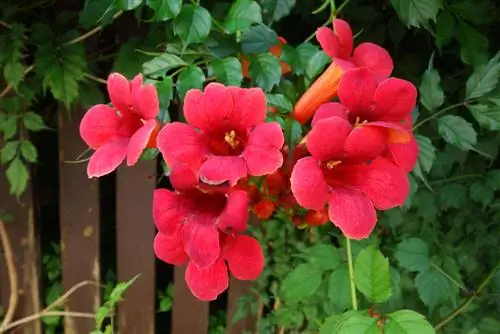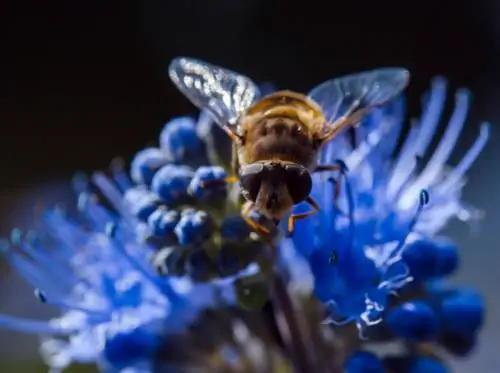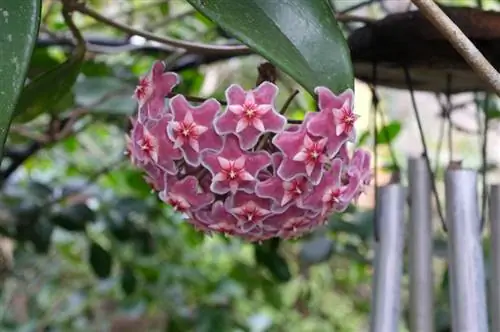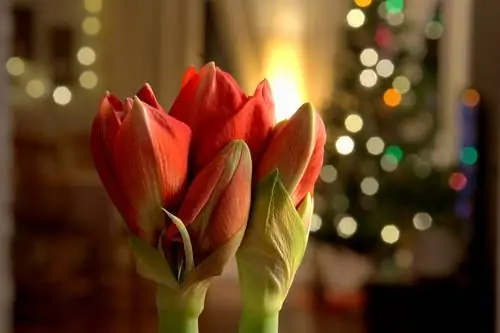- Author admin [email protected].
- Public 2023-12-25 17:45.
- Last modified 2025-01-23 11:21.
With its trumpet-shaped, lush flowers, the trumpet flower is a decorative vine - and due to its winter hardiness, a recommended alternative to the tropical angel's trumpet. What you should know about the American beauty and how best to cultivate it, read below.

What are the most important care instructions for the trumpet flower?
The trumpet flower is a hardy, woody climbing plant with showy trumpet-shaped flowers and can grow up to 10 meters high. It requires a sunny, warm location, moderately nutrient-rich and permeable soil as well as regular pruning and fertilization with compost.
Origin
The American trumpet flower, botanically Campsis radicans, which is more relevant to our local garden culture than the Chinese trumpet flower, comes, as the German name suggests, originally from America - more precisely, from the northern to central and eastern areas of the UNITED STATES. This also provides an important cultivation-technical distinguishing feature from the angel's trumpet, with which the trumpet flower is often confused - in contrast to its candidate for confusion, which comes from tropical areas, it is hardy, at least most varieties are.
The Chinese trumpet flower has its origins in eastern China and Japan and is not really hardy.
We often cultivate a hybrid of the American and Chinese trumpet flowers, the large climbing trumpet (Campsis tagliabuana).
Growth
The trumpet flower grows as a woody climbing shrub with twining tendrils that pull themselves up walls or trellises with adhesive roots. It is therefore self-climbing and does not necessarily need a climbing aid. Its growth is quite strong and, depending on site conditions, it can reach a height of up to 10 meters. But this is rare; it usually stays at half this height. In container culture it generally remains even smaller.
The Great Climbing Trumpet grows as a liana-like shrub and is just as big as the American Trumpet Flower.
The growth characteristics in key words:
- self-climbing, woody climbing shrub
- Strong growth
- Height about 5 to 10 meters
leaves
The leaves of the trumpet flower, which are up to 25 centimeters long, attach oppositely to the tendrils and create a pretty structural image with their unpaired pinnations. When they are young, they appear a bright, fresh green and later darken slightly. The individual leaves have a finely sawn edge and taper to a point at the end. In the fall, the trumpet flower sheds its leaves after they turn bright yellow. In the spring it sprouts its leaves late, around mid-May.
Bloom
The trumpet flower of course owes its name to its large, decorative flowers. They are actually shaped like a trumpet and are a stately appearance with a length of up to 7 centimeters. Their tube-like adhesions in front of the wide bulging funnel at the end are very long. The flowers are clustered in groups of around twenty at the ends of the shoots. The resulting large flower balls stand out attractively from the green foliage with their intense coloring (scarlet red to sunny yellow, depending on the variety).
On the stamens of the easily accessible flower openings, the trumpet flower offers a rich supply of nectar to useful insects that are worth protecting, such as bees and bumblebees.
The trumpet flower blossom in keywords:
- Long tubular shape with a wide, arched funnel opening
- Very intense colors from scarlet red to yellow
- Valuable food source for beneficial insects
Flowering time
The trumpet flower blooms noticeably late - it only develops its main flower over several weeks in August and September and can delight with its colorful splendor until October. If the weather conditions are good, the first flowers can appear as early as June.
Unfortunately, you will have to be patient until you can enjoy the first blossom after planting - the trumpet flower needs about 4 to 5 years until it has established itself sufficiently in its location for this feat of strength.
To remember:
- Flowering time for most varieties between July and October
- For some varieties and in warm weather even from June onwards
- First flowering after planting only after about 4 to 5 years
read more
Which location is suitable?
Trumpet flowers prefer a sunny, warm location. It should also be protected from harsh winds. It is also advantageous if, in contrast to the upper part of the plant, its base is not exposed to full sunlight. For example, you can shade the root area with a ground cover. However, this should have a loose root system so that it does not restrict the flat roots of the trumpet flower.
Trumpet flowers grow best in generally milder, drier climates than in cool, wet areas. In the south of Germany you can generally expect better success than in the northern and eastern parts of the country.
The trumpet flower does not have high demands on the soil. It should be moderately nutrient-rich, sufficiently moist, relatively loamy, but still permeable. The trumpet flower is hardly interested in the pH value; it can cope with both acidic and alkaline soils.
The location requirement at a glance:
- warm and sunny
- sheltered from the wind
- Shaded ground area
- Soil moderately nutrient-rich, moist, well-drained
- ph value doesn’t matter
Watering the trumpet flower
As a shallow rooter, the trumpet flower requires careful watering practices. Make sure that the root area does not dry out too much and water regularly, especially during longer dry periods in summer. Depending on the size of the plant, the water requirement is also greater. If you keep the trumpet flower in a pot, you will of course need to water it more regularly. However, you should avoid waterlogging as much as possible. Always wait until the potting soil has dried thoroughly before watering again.
Fertilize trumpet flowers properly
When planting, it is advisable to provide the trumpet flower with a permanent source of nutrients with ripe compost in the excavated soil. A fresh addition of compost every spring is also very good for her. However, you should not go beyond this level of organic fertilizer. Above all, avoid liquid preparations containing nitrogen - they only increase size growth to the detriment of flowering.
Cut
Since the trumpet flower generally shows strong growth, regular pruning is an essential part of its care. To rejuvenate and increase vitality, it is best to first remove all dead, dried-out branches in spring. To specifically promote lush flowering, radically shorten all long side shoots on the main shoots so that the plant is encouraged to form new short shoots. Make sure that a few buds are retained.
A trumpet flower also tolerates radical pruning well. You can return them completely to the cane - this usually results in vigorous new growth and acts as an effective, basic rejuvenation treatment. However, you will probably have to forgo flowering the following year.
The cutting rules at a glance:
- strong growing trumpet flower should be cut back regularly
- Pruning in spring
- Remove old tendrils and shorten long side shoots to promote flowering
- Rejuvenating radical pruning is well tolerated
hardy
The American and large trumpet flowers are hardy - so you can safely cultivate them outdoors permanently. However, winter hardiness is not entirely unlimited. The tolerance limit of the American trumpet flower and the hybrid is around -17°C - so cold damage cannot be ruled out in extreme winters. You should also protect freshly planted young plants from the cold in the first few years of winter with leaves and fir branches in the root area.
To remember:
- American and Great Trumpet Flowers are hardy
- Protect young specimens in particular from frost damage with branches or in a cold house in very severe sub-zero temperatures
read more
Trumpet flower in pot
You can also cultivate a trumpet flower in a container because it can be kept quite compact if cut regularly. In a solitary position, a trellis structure is still necessary to which the climbing tendrils can hold. You should make the soil substrate rich in humus and implement drainage made of coarse sand. When growing in containers, you should water and fertilize with compost in smaller steps.
The trumpet flower only needs to be repotted if the pot becomes too narrow and the roots grow out of the lower pot holes.
The trumpet flower in the pot is also a little more sensitive to frost. As a rule, it can be overwintered outside. If the temperatures fall below -10°C, it is better to put them in a cold house or cover them well with garden fleece.
To remember:
- Pot culture is possible with regular pruning
- Install trellis
- humus-rich substrate with sand drainage
- regular watering and composting
- Repotting only if the roots are narrow
- Wintering better in a cold house
Propagate trumpet flower
Recommended methods for trumpet flower propagation are:
- Lowers
- Use of foothills
Lowers
The best way to propagate a trumpet flower is using the planting method. To do this, place a woody shoot in a planter with soil in spring and secure it with a metal hook. Keep the substrate evenly moist. Rooting occurs gradually throughout the vegetation phase. You should only separate the lowering plant from the mother plant in the following year and then continue cultivating it protected from frost.
foothills
Another method is to use runners. The trumpet flower prefers to form runners in loose ground. Here you can easily access and plant the separated young plants in pots in spring.
Seed cultivation
It is of course also possible to propagate the trumpet flower using your own seeds. However, you will usually end up with a specimen that is not particularly flowery. The seeds are collected from the plant after the fruit has ripened and allowed to dry. Before sowing - which can happen all year round - they should be soaked in water for about 6 hours. The seeds take a long time to germinate in a pot with potting soil - around 4 weeks.read more
Diseases and pests
Fortunately, trumpet flowers are very resistant to diseases and pests. Common but rather harmless ailments include powdery mildew and aphids.
Mildew
You can recognize powdery mildew by the characteristic and eponymous floury coating on the leaves. However, the damage to the plant is moderate. You also don't need to use aggressive artificial means to combat it - first you should cut out the diseased parts of the plant. A spray treatment with a milk-water mixture in a ratio of 1:9 can also be helpful. If the infestation is severe or advanced, a fungicide may be necessary.
Aphids
You can usually get these parasites under control by showering them with water. What also helps is to use a decoction of nettles instead of water.
Trumpet flower not blooming
On this topic, it should first be remembered that a freshly planted trumpet flower needs 3 to 4 years until it has gathered enough strength for its first bloom. So you don't need to hope for the blaze of color during this time. If an established specimen fails to flower, this may be due to the following reasons:
- Wrong location
- Missing pruning
- Specimen grown from seed
Wrong location
The trumpet flower is an extremely sun- and heat-loving plant. A location that is too dark, cold and possibly drafty can spoil its desire to bloom. Young buds in particular can freeze under such conditions in early spring.
Missing pruning
The rejuvenation treatment in spring by pruning the shoots is very important for good flowering. Because the trumpet flower only produces flowers on the fresh shoot ends - if it is not pruned, new branches may not sprout at all.
Specimen grown from seed
A trumpet flower propagated from seedlings is generally rather reluctant to bloom. Therefore, propagating your own seeds is not recommended. However, some purchased specimens can also be grown from seeds - this method is the most cost-effective. When buying, make sure it comes from a reputable source and don't go for the cheapest offer!read more
Tip:
If you want to prevent the trumpet flower from spreading uncontrollably, cut off the fruits before they ripen. Even if the plant is very beautiful, it can also become a pest due to its great willingness to sow.
Varieties
Madame Galen
Madame Galen is one of the most common varieties of the hybrid trumpet flower Campsis tagliabuana, i.e. the large climbing trumpet, in this country. The Madame Galen has a slightly weaker growth habit than the wild Campsis radicans, but still grows to an average height of 5 meters. It should also be provided with a climbing aid. Its flowers are attractively colored with yellowish-orange tubes and a scarlet funnel opening. They open from July and usually stay until well into September.
Flava
The Campsis radicans Flava delights with its beautiful, sunny yellow flowers that appear between July and September. It grows very quickly and is therefore particularly suitable for quick green walls. The climbing tendrils quickly become overhanging, so a stable climbing aid is essential. Like its original form, the Flava needs a sunny, warm location and would like to be shaded at the roots. Compared to the wild form, this variety is slightly smaller with an average height of around 3 meters. It also doesn't tolerate very cold temperatures - you should expect it to be a maximum of -10°C.
Flamenco
This variety of American trumpet flower impresses above all with its particularly large and numerous flowers in a rich orange-red color. The flowers also generally appear a little earlier than with wild Campsis radicans. It produces around 10 to 15 flowers per cluster. In good conditions, the Campsis radicans Flamenco can reach a height of around 10 meters. It is very robust against frost.
Indian Summer
The Indian Summer variety also belongs to the hybrid species of the large climbing trumpet. It gets its name from the bright orange tone of its long flowers, which can appear as early as June and last until October. The Indian Summer prefers a sunny to partially shaded location and reaches a moderate height of around 4 to 5 meters. Since it grows very quickly, it is well suited for walls and railings that need to be covered with greenery quickly.






